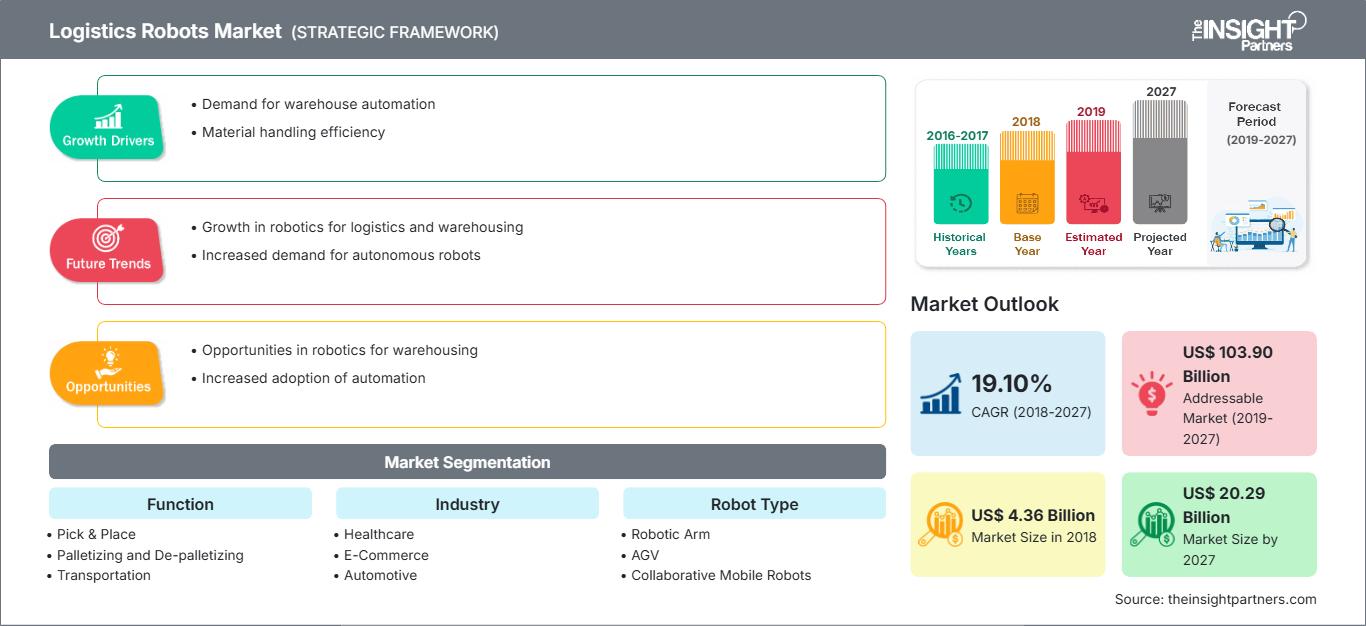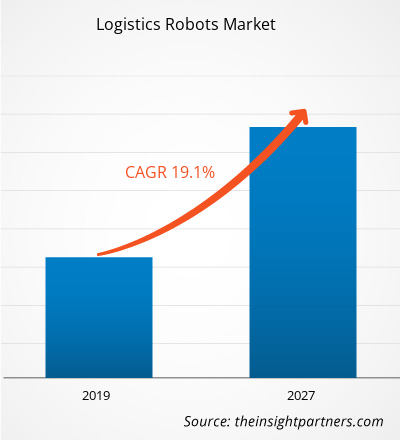物流ロボット市場は2018年に43億5,620万米ドルと評価され、2019年から2027年にかけて年平均成長率(CAGR)19.10%で成長し、2027年には202億9,340万米ドルに達すると予想されています。
市場での競争力を維持するために、効率性、スピード、利益増大のメリットを得るため、ロボット導入に積極的に取り組んでいる物流・倉庫会社の数が増加しています。手頃な価格で業務効率を高めるため、ロボット倉庫・物流技術などの先進技術の採用が進んでいます。世界の物流ロボット市場は、世界的な高齢化率の増加による労働力不足や、世界的なサプライチェーンネットワークの拡大などの要因によって牽引されていますが、予測期間中は物流ロボット導入のための高額な設備投資が物流ロボット市場の成長を抑制すると予想されます。しかし、倉庫の自動化の増加とアジア太平洋地域および欧州諸国での確立された市場は、近い将来、業界のプレーヤーに市場シェアを向上させる大きな成長機会をもたらす可能性があります。
市場洞察:世界的な高齢化人口の割合の増加が労働力不足につながる
世界中で高齢化人口の割合が増加していることは、さまざまな業界で労働力の減少の主な要因の1つです。世界中の各国で、地域社会の高齢者の数が増加しています。人口の高齢化は、労働市場と金融市場を含むすべてのセクターで、21世紀の社会変革の重要な要因の1つになっています。ただし、イタリア、日本など、さまざまな国が、65歳以上の人口のかなりの割合を考慮して、高齢化人口の割合が最大数である国を挙げています。 WHOによると、2050年までに世界で約200万人が60歳以上になると予想されており、これは2000年の3倍に相当します。高齢化人口の急増は労働力不足の原因となっています。物流ロボットの導入は、プロセス全体のコスト削減、生産性の向上、安全性の強化、人的ミスの削減など、様々な業界で重要な役割を果たしています。世界中の倉庫における急速な技術進歩は、サプライチェーンプロセスが直面する困難に関連する要件に焦点を当て、ビジネス目標に関連する技術の使用を保証しています。製品ライフサイクルのさまざまなユニット、機能、段階にわたるロボットの導入は、今日の倉庫が成長軌道に乗る上で重要な課題であり、近い将来、物流ロボット市場の拡大につながると予想されます。
要件に合わせてレポートをカスタマイズ
レポートの一部、国レベルの分析、Excelデータパックなどを含め、スタートアップ&大学向けに特別オファーや割引もご利用いただけます(無償)
物流ロボット市場: 戦略的洞察

-
このレポートの主要な市場動向を入手してください。この無料サンプルには、市場動向から見積もりや予測に至るまでのデータ分析が含まれます。
世界の物流ロボット市場では、協働型モバイルロボットが最大のシェアを獲得しました。これらの協働ロボットは、軽作業だけでなく重作業にも対応できるため、梱包、マシンテンディング、マテリアルハンドリングなど、様々な業界で導入されています。高精度、柔軟性、そして精密さを誇ります。さらに、協働ロボットはメンテナンスが容易で、再構成や再プログラミングも容易です。繊細な作業にも対応可能で、製造工程で発生する不整合に合わせて自動的に調整します。協働ロボットは、オンボード分析に必要な重要な指標を収集し、レポートを提供することで意思決定プロセスを簡素化できるため、物流ロボット市場全体を牽引しています。
機能に関する洞察
世界の物流ロボット市場では、輸送分野が最大のシェアを獲得しました。商品はパレットに積載されており、製品の形状やサイズにわずかなばらつきがあるため、これらの商品の積み込みと積み下ろしの自動化が求められています。 3Dレーザービジョンは新しいロボットソフトウェアと統合されており、ユーザーがコンテナ内のさまざまな製品を視覚化し、理想的な積み込み/積み下ろしシーケンスを決定し、プロセスを高精度で実行するのに役立ちます。 物流ロボットは、ターゲットラックの移動、バスケットの引き出しと持ち上げ、棚のフォークの伸縮、ターゲット位置への復帰に使用され、物流ロボット市場全体を牽引しています。
業界洞察
アウトソーシング物流セグメントは、世界の物流ロボット市場で最大のシェアを獲得しました。これらの物流サービスプロバイダーは、倉庫保管、在庫管理、輸送、配送、注文履行、貨物統合など、さまざまなサービスを提供しています。 タイムリーな配送管理と配送コストの削減の需要が高まり、材料の在庫記録の維持に重点が置かれるようになり、コアビジネスと予測期間中、物流ロボット市場を牽引すると予想される企業資産の削減。
企業は、世界的な事業展開を拡大し、高まる需要に対応するために、複数の市場イニシアチブ戦略を採用することが一般的です。この戦略は、主にヨーロッパとアジア太平洋地域で見られます。物流ロボット市場に参入している企業は、世界中の顧客基盤を拡大するために、研究開発への投資と拡張戦略を採用しており、これにより、企業はグローバルなブランド名を維持することも可能になります。
物流ロボット市場の地域別分析
The Insight Partnersのアナリストは、予測期間を通じて物流ロボット市場に影響を与える地域的な動向と要因を詳細に解説しています。このセクションでは、北米、ヨーロッパ、アジア太平洋、中東・アフリカ、中南米における物流ロボット市場のセグメントと地域についても解説しています。
物流ロボット市場レポートの範囲
| レポート属性 | 詳細 |
|---|---|
| の市場規模 2018 | US$ 4.36 Billion |
| 市場規模別 2027 | US$ 20.29 Billion |
| 世界的なCAGR (2018 - 2027) | 19.10% |
| 過去データ | 2016-2017 |
| 予測期間 | 2019-2027 |
| 対象セグメント |
By 機能
|
| 対象地域と国 |
北米
|
| 市場リーダーと主要企業の概要 |
|
物流ロボット市場におけるプレーヤーの密度:ビジネスダイナミクスへの影響を理解する
物流ロボット市場は、消費者の嗜好の変化、技術の進歩、製品メリットへの認知度の高まりといった要因によるエンドユーザーの需要増加に牽引され、急速に成長しています。需要の増加に伴い、企業は製品ラインナップの拡充、消費者ニーズへの対応のためのイノベーション、そして新たなトレンドの活用を進めており、これが市場の成長をさらに加速させています。

- 入手 物流ロボット市場 主要プレーヤーの概要
- ロボットアーム
- AGV
- 協働移動ロボット
- その他
物流ロボット市場 – 機能別
- ピックアンドプレース
- パレタイジングとデパレタイジング
- 輸送
- 梱包
物流ロボット市場 – 業界別
- ヘルスケア
- Eコマース
- 自動車
- アウトソーシング物流
- 小売
- 消費財
- 食品・飲料
- その他
物流ロボット市場 –地域別
-
北米
- 米国
- カナダ
- メキシコ
-
ヨーロッパ
- フランス
- ドイツ
- イタリア
- 英国
- ロシア
- その他ヨーロッパ
-
アジア太平洋地域
- 中国
- インド
- 韓国
- 日本
- オーストラリア
- その他アジア太平洋地域
-
中東 &アフリカ
- 南アフリカ
- サウジアラビア
- UAE
- その他の中東およびアフリカ
-
南米
- ブラジル
- アルゼンチン
- その他の南米
企業プロフィール
- AGV International
- Clearpath Robotics
- 株式会社ダイフク
- ファナック株式会社
- Fetch Robotics Inc.
- Kion Group AG
- KNAPP AG
- Kollmorgen
- KUKA AG
- 株式会社東芝
- 過去2年間の分析、基準年、CAGRによる予測(7年間)
- PEST分析とSWOT分析
- 市場規模価値/数量 - 世界、地域、国
- 業界と競争環境
- Excel データセット
最新レポート
関連レポート
お客様の声
購入理由
- 情報に基づいた意思決定
- 市場動向の理解
- 競合分析
- 顧客インサイト
- 市場予測
- リスク軽減
- 戦略計画
- 投資の正当性
- 新興市場の特定
- マーケティング戦略の強化
- 業務効率の向上
- 規制動向への対応






















 無料サンプルを入手 - 物流ロボット市場
無料サンプルを入手 - 物流ロボット市場